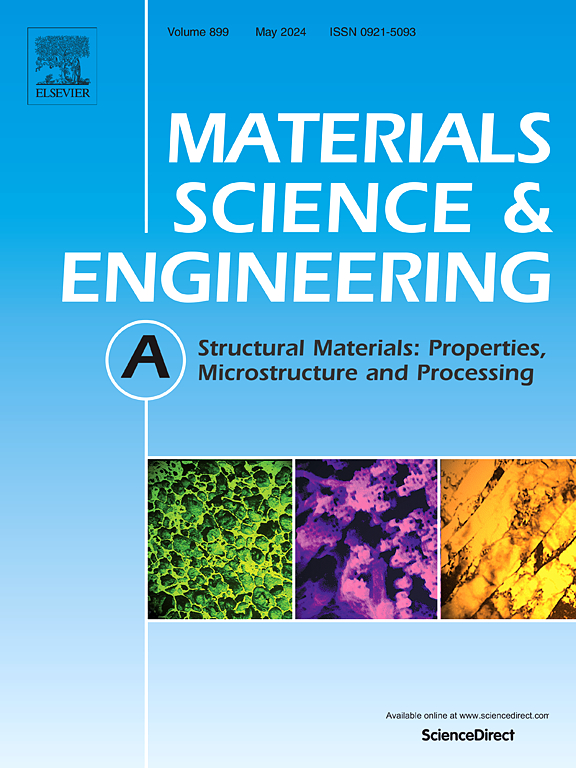结合实验和计算方法揭示加性搅拌摩擦沉积AA6061合金的加工-显微组织-性能关系
IF 6.1
2区 材料科学
Q1 MATERIALS SCIENCE, MULTIDISCIPLINARY
引用次数: 0
摘要
控制添加剂搅拌摩擦沉积(AFSD)时效硬化铝合金的显微组织、织构和力学性能的空间变化是推进该工艺在关键应用中的必要条件。本研究通过详细的显微组织分析、力学性能评估、原位EBSD拉伸测试和最先进的AA6061合金多层AFSD构建晶体塑性模拟来解决这一问题。显微硬度显著降低(~ 68 HV ~ ~ 45 HV),屈服强度显著降低(201 MPa ~ 98 MPa),织构自上而下发生变化。DSC和TEM分析表明,顶部主要由针状半相干β″相组成,底部主要由粗棒状非相干β′相组成。利用EBSD进行现场拉伸试验表明,在铸坯底部和中部,应变均匀分布在晶粒和晶界内,而在顶部区域,应变优先集中在晶界处。顶部较高的强度归因于析出(~ 53%)的显著贡献,而底部的织构和位错强化占主导地位(~ 57%)。基于晶体塑性快速傅立叶变换(CPFFT)的全场模拟,使用d本文章由计算机程序翻译,如有差异,请以英文原文为准。
Integrating experimental and computational approaches to unveil processing-microstructure-property relationships in additive friction stir deposited AA6061 alloy
Controlling spatial variation in microstructure, texture, and mechanical properties in additive friction stir deposited (AFSD) age-hardenable aluminium alloys is necessary to advance the process for critical applications. The present work addresses this issue through detailed microstructural analysis, mechanical property evaluation, in-situ EBSD tensile testing, and state-of-the-art crystal plasticity simulation of a multilayer AFSD build of AA6061 alloy. A significant decrease (∼68 HV to ∼45 HV) in microhardness, yield strength (201 MPa–98 MPa), and a variation in texture were observed from top to bottom. The DSC and TEM analysis revealed that the top region comprised mainly of needle shape semi-coherent precipitates while the bottom locations consisted of coarse rod shape incoherent precipitates. In-situ tensile test with EBSD showed that in the bottom and middle of the build, the strain was uniformly distributed within grains and grain boundaries, while it was preferentially concentrated at grain boundaries in the top region. Higher strength at the top was attributed to a significant contribution from precipitation (∼53 %), while texture and dislocation strengthening dominated (∼57 %) at the bottom of the sample. Crystal plasticity fast Fourier transform (CPFFT) based full-field simulations, using the Düsseldorf Advanced Material Simulation Kit (DAMASK), highlighted the importance of textural heterogeneity along the build direction. Micromechanical Taylor factor and T-parameters calculated from CPFFT simulation captured the in-grain heterogeneity observed experimentally. These findings highlight that in an AFSD build of age-hardenable alloys, strength is primarily controlled by the precipitates and intra- and inter-granular deformation is governed by local texture.
求助全文
通过发布文献求助,成功后即可免费获取论文全文。
去求助
来源期刊

Materials Science and Engineering: A
工程技术-材料科学:综合
CiteScore
11.50
自引率
15.60%
发文量
1811
审稿时长
31 days
期刊介绍:
Materials Science and Engineering A provides an international medium for the publication of theoretical and experimental studies related to the load-bearing capacity of materials as influenced by their basic properties, processing history, microstructure and operating environment. Appropriate submissions to Materials Science and Engineering A should include scientific and/or engineering factors which affect the microstructure - strength relationships of materials and report the changes to mechanical behavior.
 求助内容:
求助内容: 应助结果提醒方式:
应助结果提醒方式:


